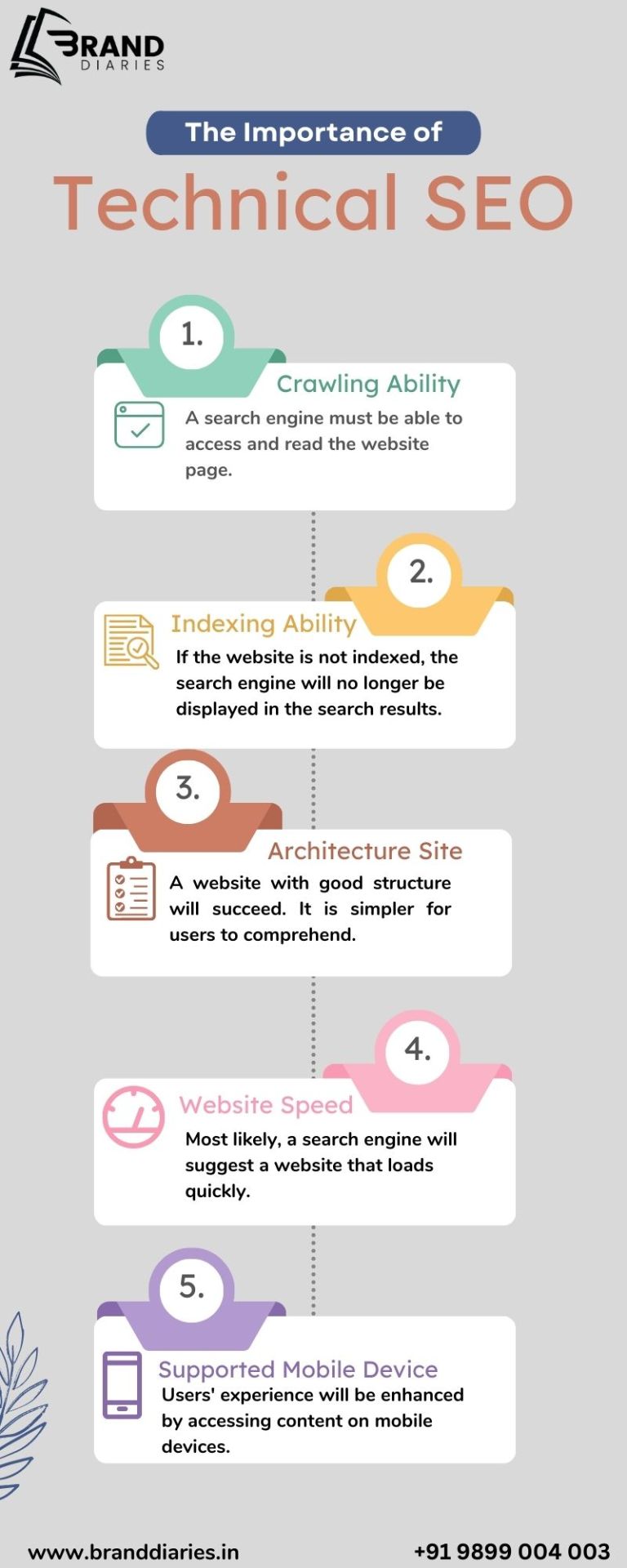#Mobile SEO is Important
Text
10 Ways to Make Your Website More User-Friendly
Introduction
A user-friendly website is very important for any business to attract and retain customers. It creates a good user experience and also increases the chances of conversions and customer satisfaction. In this article you can explore 10 effective ways to make your website more user-friendly.
Simplify Navigation
A clear navigation on your website attracts user attention.
By simplifying your website's navigation make it easier for visitors to find the information they are looking for. Write your website content into clear categories, use descriptive menu labels.

Organize Content logically
A well organized website content in a logical manner is important for a user-friendly website. Clear headings and subheadings guide users on your website's sections. Make sure that your website navigation menus allow visitors to move easily through your site.
Optimize Page Load Speed
A slow-loading website can create high bounce rates on your website and frustrate users. Optimize your website's page load speed by compressing images, minifying code. These optimizations not only improve user experience but also contribute to better search engine ranking on browser search result pages.

Also Checkout : Digital Marketing Company in Jaipur
Mobile Responsiveness
Most users use mobile for any search query, so make sure your website is mobile-responsive. Responsive design allows your website to adapt easily to different screen sizes and devices, providing an optimal user experience for both desktop and mobile users.

Improve Readability
Users only read the content from above rather than reading every word. Enhance readability by using clear and concise language, breaking up text with subheadings, bullet points, and shorter paragraphs. Choose good fonts, appropriate font sizes, and maintain sufficient contrast between text and background.
Utilize White Space
White space, also known as negative space, refers to the empty areas between elements on a webpage. White space improves content legibility, enhances visual hierarchy, and gives your website a clean and modern look.
Use Call-to-Action (CTA) Buttons
Call to Action buttons guide users to desired actions, such as making a purchase or subscribing to a newsletter. Design visual appealing CTA buttons that are easy to find and click. Use action-oriented and excitement language on these buttons to remind users to take the desired action.

Also Check : Social Media Marketing Company in Jaipur
Optimize Forms and Checkout Process
Complex and lengthy forms can frustrate users. Create your forms by asking only for required information and using autocomplete or drop-down menus when applicable. Simplify the checkout process, minimize the number of steps, and provide progress indicators to keep users informed.
Use Images and Videos
Visual content or graphics effectively engages users and improves their website experience. Include high-quality images and relevant videos during your website creation to make it good looking.

Regularly Update and Maintain Your Website
Regular updates and maintenance are important to ensure the smooth functioning of your website. Check for broken links, update outdated content, and regularly review your website for any usability issues. Providing fresh and relevant content instills trust and encourages repeat visits from users.
Conclusion
Creating a user-friendly website is not a one-time work, it is an ongoing effort. By implementing the 10 strategies outlined in this article, you can significantly improve user experience, boost customer satisfaction, and achieve your business goals effectively. A responsive website will not only attract more users but also keep them coming back for more.
FAQs
1. Why is a user-friendly website important?
A user-friendly website enhances the overall user experience, increases customer satisfaction, and improves the chances of conversions.
2. What is responsive design?
Responsive design refers to the ability of a website to adapt and optimize its layout across different devices, ensuring an optimal user experience.
3. How can I improve my website's page load speed?
Optimize your website's page load speed by compressing images, minifying code, leveraging browser caching, and using a content delivery network (CDN).
4. How can I make my website more visually appealing?
Incorporate high-quality images and relevant videos, utilize white space effectively, and maintain a clean and modern design aesthetic.
5. Why is it essential to regularly update and maintain a website? Regular updates and maintenance help ensure the smooth functioning of your website, fix any usability issues, and provide fresh and relevant content for users.
#digitalmarketing#marketing#social media marketing#jaipur#advertising#facebook advertising#arena infosolution#seo company#importance#mobile#search#SEO#seo services
0 notes
Text
Why Semantic SEO Is Crucial For E-Commerce Success
Why Semantic SEO Is Crucial For E-Commerce Success
Search engine optimization (SEO) is a crucial aspect of e-commerce success, as it determines how visible your website is in search engine results. Semantic SEO, also known as contextual or intent-based SEO, is a relatively new approach that focuses on the context and meaning behind search queries. By understanding the intent of the searcher,…

View On WordPress
#analytics tracking#Analyzing customer behavior#Benefits of semantic SEO in E commerce#Challenges of implementing semantic SEO in E commerce#Impact of Mobile Optimization on Semantic SEO#impact of voice search on semantic SEO#importance of structured data#Improving conversions#keyword research#measuring effectiveness#Role of AI in Semantic SEO#Schema markup#Semantic search benefits#User behavior analysis#User intent analysis#voice search optimization
0 notes
Text

Understand the significance of Technical SEO and its impact on your website's visibility, ranking, and user experience. Explore the importance of website speed, mobile optimization, structured data, crawlability, and other technical aspects that ensure search engines can effectively crawl, index, and rank your website. Implementing robust Technical SEO practices is vital for maximizing organic traffic, improving search engine visibility, and staying ahead of the competition
#Technical SEO importance#Website optimization for search engines#Crawlability and indexability#Mobile-friendly websites#tumblr blog#tumblr search#tumblr things#tumblrpost#tumblr settings#viral images#viral photo#viral trends#viral news#viral today now
0 notes
Text

#google analytics#seo marketing#digital marketer#digitalmarketing#seo expert#keyword research#seo company#Which type of reports is useful from Google Analytics?#Website Analysis is an important part of Search Engine Optimization. Google has provided 2 important tools to analyze website visits and th#Google Analytics is used to track the number of visits and the type of traffic flowing to your website through search engines#Google Pay per Click#Social media#and other referral sites. Through Google Analytics#one can track the site traffic for the main domain#subdomains#mobile websites#etc. Through Google admin access#one can create a site account and site property to define a custom Google Analytics code to insert into your website.#searchengineoptimization#digitalamarketing#seo#googleanalytics
1 note
·
View note
Text
How To Make Your Website Mobile-Friendly and Improve Your Search Engine Ranking
How To Make Your Website Mobile-Friendly and Improve Your Search Engine Ranking
In the era of modern technology, everyone owns a mobile device. Your mobile is faster than that slow laptop or clunky computer you have, and you can use it wherever you are, unless you’re a profound gamer or 3D artist.
According to Statista, there are currently 6.648 billion smartphone users worldwide, which equivalent to 83.37% of the world’s population. This number has increased significantly…

View On WordPress
0 notes
Text
Microsoft blames security for Surface devices' lack of Thunderbolt, removable RAM | KKG INFO
Microsoft blames security for Surface devices’ lack of Thunderbolt, removable RAM | KKG INFO
Microsoft blames Thunderbolt ports or removable RAM: an unlikely target for unsecured Surface devices.
According to Walking Cat On Twitter, a Surface Engineering Forum says security is the main reason the two features are missing from Surface tablets and laptops.
The engineer says that removable RAM poses a threat because a person can freeze it with liquid nitrogen, remove it, and then put it…

View On WordPress
#amazon seo tips#blames#blog seo tips and tricks#devices#INFO#KKG#lack#Microsoft#mobile phone seo tips#most important seo tips#RAM#removable#Security#seo tips and tricks hindi#seo tips for crafters#Surface#Thunderbolt#top 10 seo content writing tips
0 notes
Text
SEO for Informative JFashion Blogs
You might have noticed it by now, but it is a major pain to get your Tumblr blog to show up in the results of the various search engines. This is mainly because most of them switched to "mobile-first" indexing over the past few years, meaning the mobile version of your blog is what counts and that one is pretty bad by default for Tumblr.
So here a few general tips on how to get your content properly indexed:
get a responsive theme, meaning that it adjusts to the reader's screen size and therefore works as both desktop and mobile version
go into the "advanced options" of your theme editor and turn the default mobile theme OFF, it will make your desktop theme also act as your mobile one
while it's important for hashtags to be visible below posts, make sure they don't show up on the main page as the clutter can make your blog being mistaken for spam
if not already, change the inside of your title HTML to {title}{block:PostSummary}: {PostSummary}{/block:PostSummary}
fill-out the "keywords" meta with what your blog features (example: "jfashion, japanese fashion, information, outfits, inspiration, articles")
add your blog (username.tumblr.com) to Google Search Console and confirm via meta tag as it will help to optimize and boost your blog's performance on the web
at the above, go to "sitemaps" and make the search engine track your latest posts by adding /sitemap.xml
set your custom pages you want indexed to "show"
if you have any important posts you really want to make sure are properly indexed, put their link into the "URL inspection" bar on the top and it will tell you the current status as well as allow you to force indexing
After all of the above it might take a few days to see any results, and if there is anything causing issues preventing your blog from being properly indexed Google Search Console will let you know in its notifications. I recommend to check the site once a while in general as it also gives a nice overview of how people find your blog and what kind of posts they like, making it easy for you to tailor your content to their tastes. It's handy, isn't it?
Let's make jfashion info blogs great again!
180 notes
·
View notes
Text
Digital Marketing Strategy
Set Clear Goals and Objectives: The first step in creating a digital marketing strategy is to define clear goals and objectives. These goals should be specific, measurable, attainable, relevant, and time-bound (SMART). Examples include increasing website traffic, generating leads, improving brand awareness, or driving online sales.
2. Understand Your Target Audience: To effectively reach and engage your target audience, it's important to understand their demographics, interests, behaviors, and pain points. Conduct market research, analyze customer data, and create buyer personas to gain insightful information about your target audience. This will help you tailor your digital marketing efforts to resonate with them.
3. Choose the Right Digital Channels: Identify the digital channels that are most relevant to your target audience and align with your marketing goals. Common digital channels include websites, search engines, social media platforms, email marketing, content marketing, mobile apps, and online advertising. Each channel has unique characteristics and advantages, so choose the ones that best suit your business and audience.
4. Develop Content Strategy: Content is at the heart of digital marketing. Create a content strategy that focuses on delivering value to your target audience. Plan and produce high-quality content that aligns with their interests, needs, and preferences. This can include blog articles, videos, infographics, eBooks, webinars, and social media posts. Consistency and relevance are key to establishing thought leadership and building trust with your audience.
5. Optimize for Search Engines: Implement search engine optimization (SEO) strategies to improve your website's visibility in search engine results. Conduct keyword research to identify relevant search terms and optimize your website's on-page elements, such as meta tags, headings, and content. Create high-quality backlinks from reputable websites to boost your website's authority.
6. Leverage Social Media: Utilize social media platforms to connect with your audience, build brand awareness, and foster engagement. Identify the platforms where your target audience is most active and create compelling content tailored to each platform. Engage in conversations, respond to comments, and encourage user-generated content to cultivate a sense of community and brand loyalty.
7. Implement Email Marketing: Email marketing remains an effective way to nurture leads and engage with existing customers. Develop an email marketing strategy that includes personalized and segmented email campaigns. Provide valuable content, offers, and promotions to your subscribers, and automate email sequences to streamline your communication.
8. Monitor, Measure, and Adjust: Regularly monitor the performance of your digital marketing efforts using analytics tools. Track key performance indicators (KPIs) such as website traffic, conversion rates, engagement metrics, and ROI. Use the insights gained to identify areas for improvement and make data-driven adjustments to optimize your strategy.
9. Stay Updated and Evolve: The digital marketing landscape is constantly evolving. Stay updated with the latest trends, technologies, and industry best practices. Experiment with new channels and tactics to reach your audience. Continuously adapt your strategy based on market changes and feedback from your audience.
10. Evaluate and Refine: Regularly evaluate the effectiveness of your digital marketing strategy against your goals. Identify successes, challenges, and areas of improvement. Refine your strategy based on the insights gained to ensure continuous growth and success.
11. In summary, a well-rounded digital marketing strategy involves setting clear goals, understanding your audience, choosing the right channels, creating valuable content, optimizing for search engines, leveraging social media and email marketing, monitoring and measuring performance, staying updated, and evaluating and refining your approach. By following these steps, businesses can effectively harness the power of digital marketing to achieve their objectives and drive sustainable growth.

19 notes
·
View notes
Text
Responsive Web Design and Development: Creating a Seamless User Experience

In today's digital age, where mobile devices dominate the online landscape, responsive web design and development have become paramount for businesses and organizations. With a plethora of different screen sizes and resolutions, it's crucial to ensure that your website provides a seamless user experience across all devices. In this article, we will explore the concept of responsive web design and development and its importance in creating a successful online presence.
Understanding Responsive Web Design
Responsive web design is an approach to web development that focuses on building websites that adapt and respond to various screen sizes, orientations, and platforms. The goal is to create a fluid and flexible layout that adjusts seamlessly to provide optimal user experience, regardless of whether the site is accessed on a desktop, laptop, tablet, or smartphone.
Traditional web design techniques often involved creating separate versions of a website for different devices, leading to higher development and maintenance costs. Responsive design eliminates the need for multiple versions by utilizing a single codebase that intelligently rearranges and resizes content based on the user's device.
The Key Elements of Responsive Web Design
Responsive web design relies on a few key elements to ensure that websites look and function flawlessly across devices:
Flexible Grids and Layouts:
Responsive websites use flexible grids that adapt to different screen sizes. By employing relative units like percentages or ems instead of fixed pixels, elements on the page can resize and reposition fluidly. This allows content to adapt and fit into the available space, providing an optimal viewing experience.
Media Queries:
Media queries are CSS rules that apply different styles based on the characteristics of the user's device, such as screen size, resolution, and orientation. By using media queries, developers can create specific layouts and styles for each device type, ensuring that the website adapts accordingly.
Flexible Images and Media:
Images and media elements, such as videos and audio players, need to be flexible as well. Responsive web design utilizes techniques like CSS max-width property and fluid images to ensure that media content scales proportionally to fit the screen without distorting or overflowing.
Mobile-First Approach:
With the majority of web traffic coming from mobile devices, adopting a mobile-first approach has become a best practice in responsive web design. Starting with the mobile layout and progressively enhancing it for larger screens ensures that the core content and functionality are prioritized for smaller devices, resulting in a more efficient and user-friendly experience.
The Benefits of Responsive Web Design
Implementing responsive web design and development strategies can offer numerous advantages:
Enhanced User Experience:
A responsive website adjusts seamlessly to different devices, providing an optimal browsing experience for users. Content is easy to read, navigation is intuitive, and interactions are smooth, regardless of the screen size or platform used.
Improved SEO Performance:
Search engines like Google highly value responsive design, as it eliminates the need for separate URLs or duplicate content. A single, responsive website consolidates all your site's traffic onto one URL, making it easier for search engines to crawl and index your pages, leading to better search rankings.
Cost and Time Efficiency:
By adopting a responsive approach, you only need to develop and maintain a single website, reducing costs and saving time compared to creating multiple versions for different devices. Changes and updates can be applied universally, simplifying the maintenance process.
Future-Proofing Your Website:
Responsive design ensures that your website is ready for the future, as new devices with varying screen sizes and resolutions continue to emerge. By building a flexible and adaptable website, you can easily accommodate new technologies and ensure your online presence remains relevant and accessible.
Conclusion
Responsive web design and development is no longer optional but essential for creating a successful online presence. By adopting this approach, businesses and organizations can provide a seamless user experience across devices, enhance their SEO performance, and save time and resources. As technology continues to evolve, responsive design ensures that your website remains user-friendly and adaptable, enabling you to stay ahead of the curve in an ever-changing digital landscape.
Source
#AppDevelopment#WebDevelopment#MobileApps#WebApps#SoftwareDevelopment#UIUXDesign#MobileDevelopment#WebDesign#CodeLife#TechSolutions#AppDesign#MobileTech#WebDev#DigitalTransformation#ResponsiveDesign#Innovation#TechIndustry#AppSolutions#WebSolutions#CodeNerds
19 notes
·
View notes
Text
What is SEO ?
SEO, or Search Engine Optimization, is a set of practices and strategies aimed at improving a website's visibility and ranking on search engines like Google, Bing, and Yahoo. The primary goal of SEO is to increase organic (non-paid) traffic to a website by optimizing various elements, making it more relevant to search engine algorithms and user queries.
Key Components of SEO:
Keywords: Keyword Research: Identify and target relevant keywords that potential users are likely to search for. Understanding user intent is crucial for selecting the right keywords.
On-Page Optimization: Title Tags and Meta Descriptions: Craft compelling and relevant title tags and meta descriptions for each page to encourage clicks from search engine results pages (SERPs). Header Tags (H1, H2, etc.): Structure content using header tags to make it more readable for both users and search engines. Keyword Placement: Place keywords strategically within content, headers, and meta tags for better relevance.
Content Quality:High- Quality Content: Create informative, valuable, and engaging content that addresses user queries. Search engines prioritize content that provides value to users. Fresh and Updated Content: Regularly update and add new content to keep the website relevant and appealing to both users and search engines.
Backlinks: Link Building: Build high-quality backlinks from reputable and relevant websites. Backlinks are a key factor in search engine algorithms and contribute to a website's authority.
Technical SEO: Site Structure: Ensure a well-organized and easily navigable site structure. Use clean URLs, and implement breadcrumbs for better user experience and search engine crawling. Site Speed: Optimize website loading speed for better user experience and improved search engine rankings. Compress images, leverage browser caching, and minimize server response time. Mobile-Friendly Design: Ensure that the website is mobile-friendly, as Google considers mobile compatibility in its ranking algorithm.
User Experience (UX):User-Friendly Design: Create a user-friendly website design that encourages easy navigation and a positive overall experience. Page Responsiveness: Ensure that web pages adapt to various screen sizes and devices for a seamless user experience.
Local SEO: Google My Business (GMB): Optimize your Google My Business listing for local searches. Provide accurate business information, including name, address, phone number, and business hours.
Analytics and Reporting: Monitoring and Analysis: Use analytics tools like Google Analytics to track website performance, user behavior, and key metrics. Regular monitoring allows for data-driven decision-making and continuous improvement.
Why SEO is Important:
Increased Visibility: SEO enhances a website's visibility in search engine results, increasing the likelihood of attracting organic traffic.
Credibility and Trust: Websites that appear higher in search results are often perceived as more credible and trustworthy by users.
Cost-Effective Marketing: Organic traffic generated through SEO is essentially free, providing a cost-effective alternative to paid advertising.
User-Centric Approach: SEO focuses on providing a positive user experience, aligning with search engines' efforts to deliver relevant and valuable results to users.
Competitive Advantage: A well-optimized website gains a competitive edge, outranking competitors in search engine results and attracting more users.
Adaptability to Algorithm Changes: SEO professionals adapt to changes in search engine algorithms, ensuring that the website remains in compliance and maintains its ranking.
In summary, SEO is a multifaceted strategy that involves optimizing various aspects of a website to improve its visibility, relevance, and user experience on search engines. It is a fundamental component of digital marketing, contributing to a website's overall success in attracting and retaining online audiences.
5 notes
·
View notes
Text
How to Optimize Your Website for Better SEO and Higher Rankings
Greetings, my fellow digital marketing enthusiasts! As the best blog writer on Tumblr, I am excited to share my top tips on optimizing your website for better SEO and higher rankings.
Search engine optimization (SEO) is a crucial aspect of digital marketing. It involves optimizing your website's content and structure to rank higher in search engine results pages (SERPs) for relevant keywords. By optimizing your website for SEO, you can drive more organic traffic to your site, increase your visibility, and improve your online presence.
Without further ado, here are my tips for optimizing your website for better SEO and higher rankings:
Conduct Keyword Research - Start by conducting keyword research to identify the keywords and phrases your target audience is searching for. Use tools like Google Keyword Planner, SEMrush, or Ahrefs to identify relevant keywords with high search volume and low competition.
Optimize Your Website Structure - A well-organized website structure can improve user experience and make it easier for search engines to crawl and index your pages. Use a clear and simple navigation menu, organize your content into categories, and include internal links between related pages.
Optimize Your On-Page Content - Your on-page content should be optimized for both users and search engines. Use your target keywords naturally throughout your content, optimize your meta tags, and include internal and external links.
Focus on User Experience - Search engines prioritize user experience, so it's important to make sure your website is easy to navigate, loads quickly, and is mobile-friendly. Use responsive design, compress images, and minimize the use of JavaScript and CSS to improve page speed.
Build High-Quality Backlinks - Backlinks are an important ranking factor in SEO. Focus on building high-quality backlinks from relevant and authoritative websites to improve your website's authority and rankings.
By following these tips, you can optimize your website for better SEO and higher rankings, driving more traffic and improving your online presence.
I hope you found these tips helpful. If you have any questions or comments, feel free to leave them below.
#my writing#marketing#SEO#digitalmarketing#ecommerce#businessservices#keywords#websiteoptimization#contentmarketing#onpageoptimization#backlinks#userexperience
28 notes
·
View notes
Text
Tresses And Traffic: SEO Benefits For Your Hair Salon Business

In the competitive world of the beauty industry, a strong online presence is essential for attracting and retaining clients. If you own a hair salon, you’re likely aware of the importance of offering excellent services and creating a welcoming atmosphere, but to reach a wider audience and boost your salon’s success, it’s crucial to invest in Search Engine Optimization (SEO). This article will explore the significance of SEO for your hair salon business and provide you with valuable insights on how to leverage its benefits to increase web traffic and grow your clientele.
The Power of SEO for Hair Salons
SEO, or Search Engine Optimization, is the practice of optimizing your website and online presence to rank higher in search engine results pages, such as Google, Bing, and Yahoo. A well-executed SEO strategy can benefit your hair salon in numerous ways:
Increased Visibility: Higher search engine rankings lead to increased online visibility. When potential clients search for hair salons or related services, having your salon listed on the first page of search results dramatically improves the chances of being found.
Targeted Traffic: SEO enables you to target specific keywords and phrases relevant to your business. This means that the users who discover your website are more likely to be interested in your services, which increases the conversion rate.
Credibility and Trust: Websites that appear at the top of search results are often perceived as more trustworthy and reputable. By optimizing your website, you can build trust with potential clients.
Cost-Effective Marketing: SEO can be a cost-effective marketing strategy in the long run. While it may require an initial investment, the results can be long-lasting, and you won’t have to pay for clicks or impressions like with paid advertising.
Local SEO: For hair salons, local SEO is especially critical. It can help you target clients in your area and boost your chances of being chosen for hair services in your locality.
Now, let’s delve into practical tips on how to harness the SEO benefits for your hair salon business:
1. Keyword Research
Start your SEO journey by conducting thorough keyword research. Identify the keywords and phrases potential clients use to search for hair salon services. Tools like Google Keyword Planner can help you discover high-traffic and relevant keywords. Once you have your list, naturally incorporate these keywords into your website content, including your service pages and blog posts.
2. Optimize Your Website
Your website is the digital face of your hair salon and needs to be SEO-friendly. Ensure your website is mobile-responsive, loads quickly, and has an intuitive design. Structure your website logically with clear navigation to make it easy for visitors to find the information they need.
3. Content Creation
High-quality, informative content is vital for SEO success. Regularly publish blog posts that offer valuable information related to hair care, styling, and trends. Content can include styling tips, hair care routines, product recommendations, and more. Engaging content not only attracts visitors but also keeps them on your website longer, which positively impacts your search rankings.
4. Local SEO
Given the local nature of your hair salon business, local SEO should be a top priority. Ensure your website is listed in local directories, and create a Google My Business profile. This will help your salon appear in local map results, which are often displayed prominently in search results for location-specific queries.
5. Backlinks and Online Reviews
Build a network of high-quality backlinks to your website by partnering with other local businesses or seeking guest posting opportunities. Encourage satisfied clients to leave online reviews on platforms like Google, Yelp, and Facebook. Positive reviews can improve your online reputation and positively affect your SEO.
6. Monitor and Analyze
Regularly monitor your website’s performance using tools like Google Analytics. Analyze your website traffic, user behavior, and conversion rates. This data can help you refine your SEO strategy and make informed decisions on how to improve your online presence.
In conclusion, harnessing the SEO benefits for your hair salon business can significantly impact your success in the digital age. By focusing on keyword research, website optimization, content creation, local SEO, backlinks, and regular analysis, you can attract more clients and solidify your salon’s reputation as a trusted name in the industry. SEO is a long-term investment that, when executed correctly, can bring sustained growth to your hair salon and establish your brand as a top choice for beauty and hair care services.
Source:
#kushitworld#india#saharanpur#itcompany#seo#seo services#webdevelopment#digitalmarketing#websitedesigning#websiteranking#hair salon#hairsalonusiness#salonsuccess
10 notes
·
View notes
Text
Essential Elements of On-page SEO

On-page SEO is a critical aspect of optimizing web pages to enhance their search engine visibility and improve rankings. These optimizations involve various elements that contribute to both user experience and search engine understanding of your content. Here are the essential elements of on-page SEO:
High-Quality Content: The cornerstone of on-page SEO is high-quality, relevant content. Create content that addresses the needs and queries of your target audience. Well-written, informative content not only engages visitors but also signals to search engines that your page is valuable.
Keyword Optimization: Incorporate relevant keywords naturally into your content. Focus on the primary keyword for the page in strategic locations such as the title tag, headings, meta description, and throughout the body of the content. Avoid keyword stuffing, and aim for a natural and coherent flow.
Title Tags: Craft compelling and descriptive title tags for your pages. The title tag is a crucial on-page SEO element and is often used as the main headline in search engine results. Include the primary keyword and make the title tag enticing to encourage click-throughs.
Meta Descriptions: Write concise and informative meta-descriptions that provide a brief overview of the page's content. While meta descriptions may not directly impact rankings, they influence click-through rates, making them important for attracting users from search engine results pages.
Header Tags (H1, H2, H3, etc.): Use header tags to structure your content. The H1 tag represents the main heading and should include the primary keyword. Subheadings (H2, H3, etc.) break down the content into sections, improving readability and helping search engines understand the hierarchy of information.
URL Structure: Create clean and descriptive URLs that reflect the content of the page. Avoid generic URLs with strings of numbers or symbols. Include relevant keywords and maintain a clear structure for both users and search engines.
Image Optimization: Optimize images by using descriptive file names and adding alt text. Alt text provides a textual description of an image, aiding accessibility and allowing search engines to understand the content. Compress images to improve page load times.
Internal Linking: Incorporate internal links within your content to connect related pages on your website. Internal linking helps distribute page authority, enhances navigation, and encourages users to explore more of your content.
External Linking: Include authoritative external links to reputable sources when relevant. Outbound links provide additional context to your content and contribute to your page's credibility in the eyes of search engines.
If you’re ready to boost your link-building tactics in 2023 and beyond, then connect with an expert SEO company in Chandigarh.
User-Friendly URLs: Ensure that your URLs are user-friendly and easy to comprehend. A well-structured URL not only benefits SEO but also improves the overall user experience.
Mobile Responsiveness: With the increasing use of mobile devices, having a mobile-responsive website is crucial. Google considers mobile-friendliness as a ranking factor, so ensure that your pages adapt seamlessly to various screen sizes.
Page Loading Speed: Page loading speed is a critical factor for both user experience and search rankings. Optimize images, leverage browser caching, and utilize content delivery networks (CDNs) to enhance page load times.
Schema Markup: Implementing schema markup can provide additional context to search engines about the content on your page. This structured data can enhance the appearance of your snippets in search results through rich snippets.
User Engagement Metrics: Factors such as bounce rate, time on page, and click-through rate can indirectly impact SEO. Engaging, valuable content that keeps users on your site contributes to better search engine rankings.
Social Media Integration: While not a direct ranking factor, social signals can influence SEO indirectly. Integrate social sharing buttons and encourage users to share your content, expanding its reach and potential impact on search visibility.
By focusing on these essential elements of on-page SEO, you can create a well-optimized website that not only performs well in search engine results but also provides a positive and informative experience for your visitors. Keep in mind that SEO is an ongoing process, and regularly updating and optimizing your content is key to sustained success.
7 notes
·
View notes
Text

RankBrain is a machine learning algorithm that Google uses to help rank websites in search results. It is one of the most important factors in Google's ranking algorithm, and it is constantly evolving.
To effectively rank in the future, you need to understand how RankBrain works and how you can optimize your website for it. Here are some tips:
Create high-quality content. RankBrain is trained on a massive dataset of text and code, so it is able to understand the quality of your content. Create high-quality content that is relevant to your target audience and that is well-written and informative.
Optimize your website for search engines. This includes using relevant keywords in your title tags, meta descriptions, and throughout your content. You should also make sure that your website is mobile-friendly.
Build backlinks to your website. Backlinks are links from other websites to your own. Backlinks are a signal to Google that your website is authoritative and trustworthy. You can build backlinks by creating high-quality content that other websites will want to link to, and by guest blogging on other websites in your industry.
Promote your content. Once you have created high-quality content, you need to promote it so that people can find it. You can promote your content on social media, through email marketing, and by guest blogging on other websites. You can also promote your content by submitting it to directories and by running paid advertising campaigns.
In addition to the above tips, there are a few other things you can do to effectively rank in the future:
Keep up with the latest SEO trends. The SEO landscape is constantly changing, so it is important to keep up with the latest trends. You can do this by reading industry blogs, attending industry events, and following SEO experts on social media.
Use data to inform your SEO strategy. You can use data from analytics tools to see what content is performing well and what content is not performing well. This data can help you to create more of the content that your audience wants to see.
Be patient. It takes time to rank in search results, especially for competitive keywords. Don't expect to see results overnight. Just keep creating high-quality content, building backlinks, and promoting your content, and you will eventually see results.
By following the tips above, you can improve your chances of ranking effectively in the future.
Here are some additional tips specifically for RankBrain:
Focus on long-tail keywords. RankBrain is better at understanding long-tail keywords than short-tail keywords. This is because long-tail keywords are more specific and informative.
Create content that is relevant to your target audience. RankBrain is able to understand the context of your content and the intent of your target audience. This means that you need to create content that is relevant to your target audience and that meets their needs.
Use a variety of content formats. RankBrain is able to understand a variety of content formats, including text, images, videos, and audio. This means that you can create content in a variety of formats to reach your target audience and improve your ranking.
Keep your website up-to-date. RankBrain favors websites that are fresh and up-to-date. This means that you need to update your website on a regular basis with new content.
By following these tips, you can optimize your website for RankBrain and improve your chances of ranking effectively in the future.
Mapiranje ključnih reči
#seo#seo srbija#dizajn#optimizacija sajta#optimizacijasajta#seo expert srbija#seo blog#ranking#RANK BRAIN#SEARCH#OPTIMIZED#video seo#linkedin#linkedin seo#linkedin marketing
8 notes
·
View notes
Text
How can I make a SaaS website design with WordPress tips?
Designing a SaaS website using WordPress? Adhere to these guidelines for a professional website that effectively highlights your services and focuses on conversions.
Select an appropriate theme: Choose a WordPress theme that is a good match for displaying SaaS products. Search for themes that provide sleek designs, customizable layouts, and compatibility with common plugins.
Emphasize the importance of being clear and simple: Your website needs to effectively convey the value of your SaaS design services. Maintain a simple design, easy-to-use navigation, and content that is easy to understand.
Showcase your past SaaS website design projects prominently on your website to spotlight your portfolio. Demonstrate your expertise and the quality of your work by utilizing case studies or portfolio galleries.
Optimize your website with the focus on increasing conversion rates. Utilize distinct calls-to-action (CTAs) to prompt visitors to reach out to you or ask about your services. Think about incorporating lead capture forms or chatbots to interact with visitors and gather leads.
Optimize your website to ensure it is fully responsive and mobile-friendly. It is essential for the user experience to be consistent across all devices since a large number of users will be accessing the site via smartphones or tablets.
Implementing SEO best practices is important for enhancing your website's presence in search engine results. This involves maximizing meta tags, utilizing informative headings, and producing top-notch, keyword-optimized content.
Incorporate testimonials, client logos, or case studies to establish trust with potential clients by integrating Social Proof. Utilizing social proof can show your reliability and persuade visitors to select your services.
Give Easily Understandable Information about Your Services: Clearly define the services you provide, like the process for designing SaaS websites, pricing choices, and any extra services like maintenance or support.
Add a blog: Have a blog to post helpful information on SaaS website design, web development trends, case studies, and industry insights. Frequently updating your blog can increase traffic to your website and position you as an expert in your industry.
Frequent Updates and Maintenance: Ensure your website is always current by staying on top of the latest WordPress core, theme, and plugin updates. Frequent upkeep guarantees safety, efficiency, and alignment with modern technologies.
#SaaSwebsite#SaaSWebsiteDesign#WordPressWebsiteDevelopment#DigitalDesign#WebDevelopment#WebsiteDesign#OnlinePresence#TechSolutions#CustomWebsite#UserFriendlyDesign#EcommerceIntegration
3 notes
·
View notes